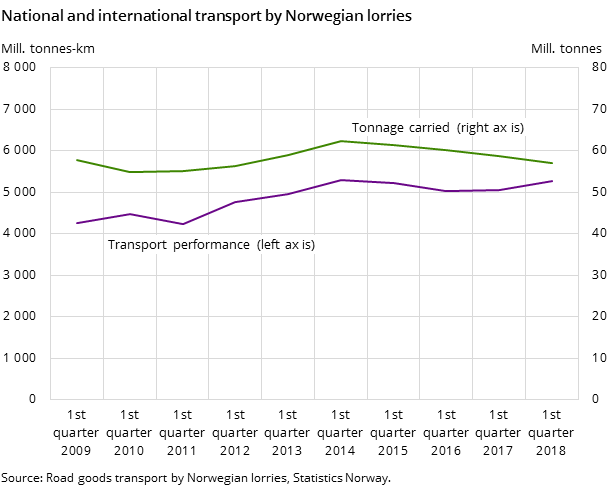Increase in transport performances continues
Published:
Norwegian lorries performed almost 5.3 billion tonne-kilometres in Norway and on trips abroad in the 1st quarter of 2018. This was an increase of 4.5 per cent compared with the 1st quarter of 2017.
- Full set of figures
- Road goods transport by Norwegian lorries
- Series archive
- Road goods transport by Norwegian lorries (archive)
The transport performance of Norwegian-registered vehicles in national transport increased by 3.5 per cent during the 1st quarter of 2017. The transport performance in international transport increased by 13.0 per cent in the same period. The average length of carriage of goods transported domestically increased from 77.8 to 83.1 kilometres in the 1st quarter this year.
Less domestic transport
In the 1st quarter of 2018, Norwegian lorries carried 55.8 million tonnes of goods domestically. This is 3.0 per cent less than in the 1st quarter of 2017. The tonnage carried, related to exports and imports was almost unchanged during the same period, and constituted 1.2 million tonnes. Domestically, it was especially the mass transport that contributed to the decrease in transport carried, with a decrease of 4.6 per cent from the same quarter last year. The timing of Easter may have contributed to this decline since the entire Easter holiday this year was in the 1st quarter, while Easter last year was in the second.
Figure 2. National transport tonnage carried by commodity. 1st quarter 2018
| Tonnage carried (mill.tonnes) | |
| Agricultural products, forestry products, fishing products 14.7% | 8.2 |
| Food products, beverages, tobaco and animal fodder 9.1% | 5.1 |
| Coal, oil and chemicals and chemical products (incl. fertilizer) 6.3% | 3.5 |
| Metal ores, stone, sand, gravel, clay, salt, cement, lime, manufactured construction materials 55.7% | 31.1 |
| Other manufactured goods, grouped goods and other goods 14.2% | 7.9 |
Figure 3. National transport performance by commodity. 1st quarter 2018
| Transport performance (million tonne kilometres) | |
| Agricultural products, forestry products, fishing products 15.1% | 699.7 |
| Food products, beverages, tobaco and animal fodder 20.7% | 960.3 |
| Coal, oil and chemicals and chemical products (incl. fertilizer) 13.7% | 634.1 |
| Metal ores, stone, sand, gravel, clay, salt, cement, lime, manufactured construction materials 24.3% | 1124.5 |
| Other manufactured goods, grouped goods and other goods 26.2% | 1213.9 |
Domestic transport dominates completely
Of the total tonnage carried by Norwegian lorries in the 1st quarter this year, 98 per cent was transported domestically. The trips to and from abroad are on average longer, than domestic trips. Consequently, the domestic transport performance represents a smaller proportion of the total than the transported amount. 87.8 per cent of the transport performance was carried out within the first quarter of 2018.
More empty kilometres
The rate of empty kilometres for national transport increased from 28.2 to 29.7 per cent from the 1st quarter of 2017 to the corresponding quarter in 2018. The rate for international transport decreased from 24.1 to 18.3 per cent in the same period.
Figure 4. National transports. Vehicle kilometres by Norwegian lorries
| Unloaded vehicle-kilometres | Vehicle kilometres with load | |
| Q1 2009 | 103.6 | 290.2 |
| Q12010 | 99.4 | 290.2 |
| Q12011 | 100.6 | 294.8 |
| Q12012 | 114.6 | 342.1 |
| Q12013 | 109.6 | 350.1 |
| Q1 2014 | 120.2 | 356.8 |
| Q1 2015 | 125.0 | 378.3 |
| Q1 2016 | 125.1 | 324.3 |
| Q1 2017 | 130.7 | 332.8 |
| Q1 2018 | 135.0 | 319.2 |
Contact
-
Nataliya Granerud
-
Statistics Norway's Information Centre

